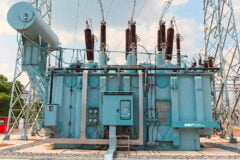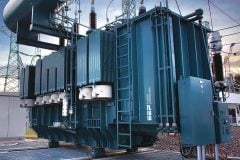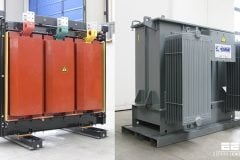Transformer Price and Losses
The Connection
Losses and purchase price should be considered when deciding which transformer to purchase. The purpose of this technical article is to present a uniform approach that can be used to determine the dollar value of these losses over the life of the transformer.

Below is typical wording of a transformer loss evaluation clause for insertion into bidding documents that specifies how losses will be evaluated.
- No-Load Losses $/kW 2450
- Load Losses $/kW 1304
- Auxiliary Losses $/kW 756
The cost of losses for each transformer will be calculated by multiplying the appropriate dollars/kW values above by the guaranteed load losses at 55°C rating and no-load losses at 100% voltages. This cost will be added to the bid price for evaluation.”
Let’s see an example //
Using the loss evaluation factors given above, determine which manufacturer’s transformer has the lowest evaluated cost including losses.
161/34.5 kV, 30/40/50 MVA Transformer
| Manufacturer A’s Transformer | Manufacturer B’s Transformer | |
| Bid price | $424,500 | $436,000 |
| No -load losses | 59 kW | 53 kW |
| Load losses at 50 MVA (at 55°C temperature rise) | 224 kW | 218 kW |
| Auxiliary losses (at 50 MVA 55°C temperature rise) | 2.0 kW | 2.5 kW |
… and play with numbers //
| Manufacturer A’s Transformer | Manufacturer B’s Transformer | |
| Bid Price | = $424,500 | = $436,000 |
| Total cost of No-load Losses | 59 kW (2450 $/kW) = $144,550 | 53 kW (2450 $/kW) = $129,850 |
| Total cost of Load Losses | 224 kW (1304 $/kW) = $292,096 | 218 kW (1304 $/kW) = $284,272 |
| Total cost of Auxiliary Losses | 2.0 kW ( 756 $/kW) = $ 1,512 | 2.5 kW (756 $/kW) = $1,890 |
| TOTAL COST // | = $862,658 | = $852,012 |
Although the transformer from Manufacturer A has the lowest bid price, it is obvious that the transformer from Manufacturer B has the lowest evaluated total cost.
Bidding and Penalty Values
In addition to giving loss evaluation values, the bid documents should also have penalty values that the manufacturer is to be charged for every kilowatt by which the actual tested transformer losses exceed the guaranteed losses upon which the bids are evaluated.
An increment of approximately 20 percent is recommended.
Few words about above mentioned losses //
The three different types of transformer losses that should be evaluated separately are:
- Load losses (sometimes called copper or coil losses);
- No-load losses (sometimes called core or iron losses); and
- Auxiliary losses (electric fan losses, other such equipment losses).
Load losses are primarily from the I2R losses in the transformer windings and eddy current losses. If a value of load losses is not directly given, load losses can be determined by subtracting no-load losses from total losses (If the total losses at full load are 100 kW and the no-load losses are 10 kW, then the load (or copper or coil) losses are 90 kW).
No-load losses consist of the hysteresis and the eddy current losses in the iron core of the transformer and the I2R losses in the windings due to the excitation current.
Auxiliary losses consist of the power necessary to drive the auxiliary cooling pumps and fans.
The formulae below yield the total costs of the losses that should be added to the purchase price of the transformer as shown in the example above:


Where:
- G = peak ratio
- K = peak responsibility factor
- SI = the system capital investment in dollars per kilowatt required to supply the power losses of the transformer;
- 8760 = the number of hours in a year
- EC = the cost of energy in dollars per kilowatt-hour;
- FCR = fixed charge rate for capital investment expressed as a decimal in dollars per dollar of investment;
- LFA = the loss factor for auxiliary equipment;
- LFT = the transformer loss factor which is the ratio of average transformer losses to peak transformer losses;
- TNLL = the transformer’s guaranteed no-load losses in kilowatts;
- TLL = the transformer’s guaranteed load losses in kilowatts;
- TAL = the losses due to transformer auxiliary equipment in kilowatts
Values for formulae
SI – System Investment Charge
The System Investment (SI) charge is the cost of generation and transmission facilities per kilowatt necessary to supply the additional demand resulting from the transformer losses at the system peak.
Since a transformer located directly at a generating station does not require an investment in transmission facilities, the SI value used to evaluate the losses in the generating station transformer should be less than the SI of a transformer to be located at the receiving end of a transmission line.
If power is purchased rather than self-generated, the SI value can be determined by dividing the demand charge in dollars per kW per year by the fixed charge rate (FCR). Since there is more than one method of evaluating the SI value, the method that is judged to yield the most realistic results should be used.
FCR – Fixed Charge Rate
The fixed charge rate (FCR) represents the yearly income necessary to pay for a capital investment. FCR is expressed as a percentage of capital investment. The rate covers all costs that are fixed and do not vary with the amount of energy produced.
The rate includes interest, depreciation, taxes, insurance, and those operations and maintenance expenses that do not depend on system kilowatt-hours sold. The interest rate used should be the same as the interest rate of the loan acquired to purchase the transformers. If loan funds are not used, a blended rate of the interest earned on deposited funds should be used.
The practice of including some operations and maintenance expenses in the fixed charge rate is a matter of judgment. Some typical values for the components of the carrying charge rate are as follows:
| Interest | 7.5% |
| Depreciation | 2.75% |
| Insurance | 0.60% |
| Taxes | 1.00% |
| Operations and Maintenance Carrying | 2.76% |
| Carrying Charge Rate | 14.61% |
EC – Energy Charge
The energy charge (EC) is the cost per kilowatt-hour for fuel and other expenses that are directly related to the production of electrical energy.
Equations 1 and 2 are based on the assumption that the energy charge remains constant throughout the life of the transformer. If power is purchased, EC will be the kWh (or energy) cost of power.
K – Responsibility Factor
The peak responsibility factor (K) is intended to compensate for the transformer peak load losses not occurring at the system peak losses. This means that only a fraction of the peak transformer losses will contribute to the system peak demand.
The value of K can be determined from:


NOTE: It should be pointed out that K is squared in Equations 2 and 3 because K is a ratio of loads while losses are proportional to the load squared. Any value of K that seems appropriate can be used.
The following are recommended values that appear to be reasonable.
| Transformer Type | K | K2 |
| Generator Step-up | 1.00 | 1.00 |
| Transmission Substation | 0.90 | 0.81 |
| Disrtribution Substation | 0.80 | 0.64 |
LFT
The transformer loss factor is defined as the ratio of the average transformer losses to the peak transformer losses during a specific period of time. For the sake of simplicity, the equations assume that the transformer loss factor is a constant and that it does not change significantly over the life of the transformer.
The transformer loss factor can be determined directly using the equation:


LFT can also be approximated from the load factor (the average load divided by the peak load for a specified time period) using the empirical equation below:


Where:
![]()
![]()
G – Peak Ratio
The peak ratio is defined by the equation:


For the peak annual transformer load, the one hour integrated peak value should be used. The purpose of the peak ratio is to relate the value of Equation 2 to the full rated transformer load and not to the peak transformer load that would otherwise result if G were not in the equation.
If the total kVA of all transformers is known for your system and the peak kW (or kVA) load is known, then the average peak ratio for your system would be:
![]()
![]()
If the peak kW is known, but the peak kVA is unknown, assume a reasonable power factor on peak and calculate peak kVA as follows:
kVA = kW / power factor
If the transformer being purchased has a peak ratio different from the average, use that value. If the transformer will be installed at a known substation, use the billing data and assumed load growth for that substation.
The equations above are based on the assumption that the peak annual transformer load remains the same throughout the life of the transformer. If the load on the transformer is expected to increase annually, then use a reasonable equivalent level yearly peak load value based on experience even though the expected peak loading value will increase every year.
LFA – Auxiliary Loss Factor
The auxiliary loss factor compensates for the transformer auxiliary equipment that operates during only part of the transformer’s load cycle. For a transformer with two stages of cooling:
The choice of the proper probabilities in the above equation is a matter of judgment based on historical system loading patterns. It is expected that the above probabilities under normal loading patterns will be extremely low.
Since energy use and losses associated with transformer auxiliaries are extremely small over the life of the transformer, they could be ignored. The capital cost associated with auxiliaries are significant and should be considered.
Simplified Losses Calculation Tool //
Download free MS Excel Spreadsheet for calculation of transformer losses


Reference // Guide for the Evaluation of Large Power Transformer Losses – United States Department of Agriculture – Rural Utility Service











i want to know sir if we can write in our bids the permissible maximum and minimum value of losses for power transformers that the companies can’t exceed .
i search in standards and can’t find such values for the limits
thank you
A couple of things that are not fully addressed by this calculation. These of course are related
1. What is the appropriate number of years over which to evaluate the NPV of the losses?
2. Am i willing to pay $x today to save $x in NPV over the life of the transformer. Probably not as this is does not adequately take into account energy price forecast uncertainty. I generally would be willing to pay $.75 today in capital cost to save $1.00 in NPV
Please tell as why there is difference in the price of different types of losses?. Can’t it be same for all the losses as all the losses are measured in same unit.
There are different formula applied to the each of the mentioned losses, that’s the reason for difference in prices per losses.